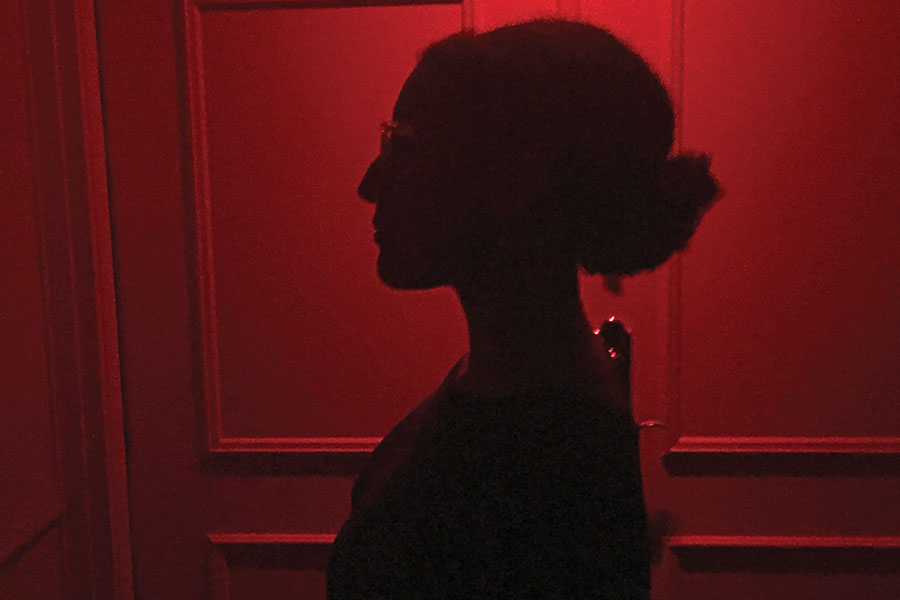Crunch and Ooze
Last Halloween in Austin, Shakespeare in the Dark: Macbeth took the stage at the historic and allegedly haunted Driskill Hotel. Adding to the spookiness—and giving special power to its sound designer, Emily Duncan Wilson—the show was performed in pitch blackness, with the audience seated in the middle of moving actors and four audio speakers.
When the show, a co-production of Past is Prologue Productions and the Filigree Theatre, was in the planning stage, Wilson gave the producers a wish list of three tiers of equipment. It included “top-tier equipment, middle-tier equipment, and then a list of just the necessities,” she recalled. After the budget was reviewed, only the necessities remained. But Wilson said she found the constraint creatively freeing. “It was awesome,” Wilson said. “In the beginning, it was like doing a radio play.”
Indeed, she felt this production allowed her more of a directorial and dramaturgical stake than a sound designer—or any designer—is typically allowed. “Sometimes sound designers are brought on to navigate the crickets and doorbells,” Wilson said. “With this show, there was a lot more to figure out.”
One of her favorite challenges was figuring out how to differentiate separate locations, as well as mark the passing of time.
“We established the difference between Macbeth and Macduff’s castles with sound,” she said. “In Macbeth’s castle, there was an ominous, slow dripping. In Macduff’s, there was a crackling fireplace.” For outdoor scenes Wilson set the scene with forest sounds.
Audio Player Audio PlayerThe more homely sounds of Macduff's castle (below) stand in contrast to the ominous overtones of Macbeth's castle.
Wilson had worked with director Jennifer Sturley before this Macbeth. Because of their familiarity, Wilson said, the two were able to build an exciting “sonic iconography” to set the scenes.
When asked about her proudest moment in the show, Wilson said, “One of the stabbings had to be especially ‘stabby’ and gruesome.” The challenge in depicting such violence aurally, she
said, is that you want it to be “not so gruesome that it will take away from the show, but just gruesome enough to be believable.”
She ended up finding a sound clip called something like “food squeeze with someone cutting toast,” which mixed the sound of a cringey crunch alongside the oozing sound of a bloody stabbing.
Another wrinkle: This “completely ego-free collaboration,” as Wilson called it, was conducted completely remotely, as she’s based in New Haven, Conn., where she’s pursuing her MFA at Yale School of Drama. So she Skyped in and out of rehearsals and was available via text during tech. Thank goodness sound travels.
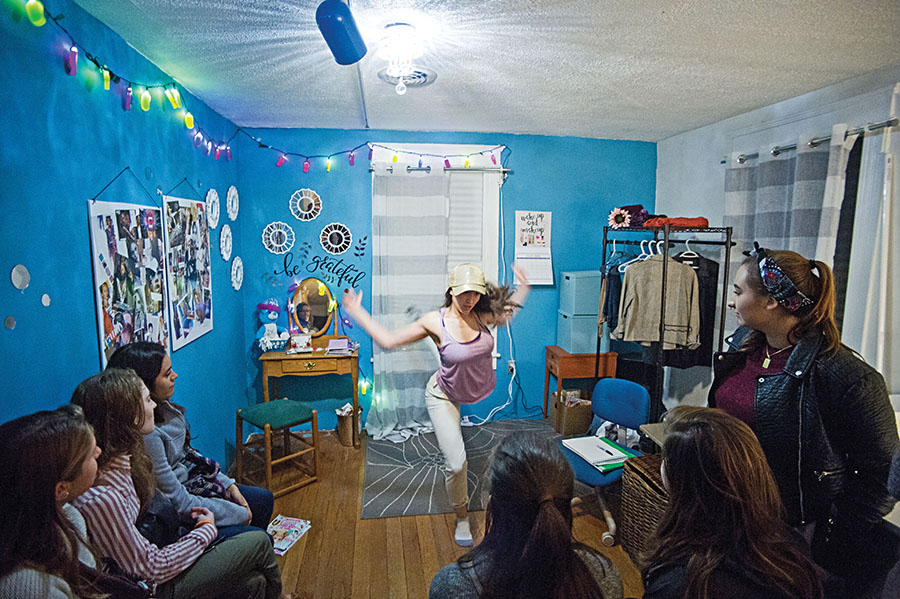
Home Is Where the Sound Is
In a seven-room home/arts space in the Takoma neighborhood of Washington, D.C., in fall 2017, Debra Kim Sivigny’s Hello, My Name Is… showcased the unique but shared experiences of adoptees through an intricately immersive piece.
“It wasn’t a traditional play,” explained sound designer Roc Lee. Alongside the usual bustle of developing new work, the team of Hello, My Name Is…, produced by the Welders, had to navigate producing a play inside the home-like environs of an alternative arts space called Rhizome.
“With 15 people in a bedroom, everyone has a different vantage point,” Lee said. “And it was difficult getting people to go where you wanted them to,” he remembered with a laugh. Sometimes music would play from a certain room, in an attempt to lure audiences there. “Most people took the hint, but some people tried to explore other places,” he said. The solution: find ways to block certain paths, or have actors gently steer audience members to certain rooms with ad libs.
“For one scene in the show, the guests went outside,” said Lee. “And while they were out, stage managers had to run around inside to move speakers and change what was plugged in.” In this way, the limitations of performing inside a house added both an extra challenge and extra charm.
The design was a mix of real and theatrical. Lee recounted a magical moment when audience members put on headsets to take a sound journey with their eyes closed—a trip across years and cities, evoking the experience of someone adopted from Seoul.
All the design elements of the show, from an outdoor wedding to a character writing a letter while accompanied by an Imagine Dragons song, evoked a certain nostalgia. In another moment, a song moved from playing out of a CD player’s speakers to emanating all around the environment. The technical effort of achieving this effect was tedious, Lee admitted, but when it worked it was worth the effort.
It helped, Lee said, that Sivigny, the playwright, is “primarily a designer herself. So the play that came together was more of a design process than anything.” The result, he said, captured how adoptees live a specific but in many ways common experience.
Now, Lee said, he’s even more interested in immersive, location-specific environments. A composer and a designer, he develops sound for theatre, video games, and film—or sometimes all at once.
Audio PlayerIn this scene in Hello, My Name Is..., the character June travels to Korea to try and find her birth mother. From Lee: "This is best listened to on headphones."
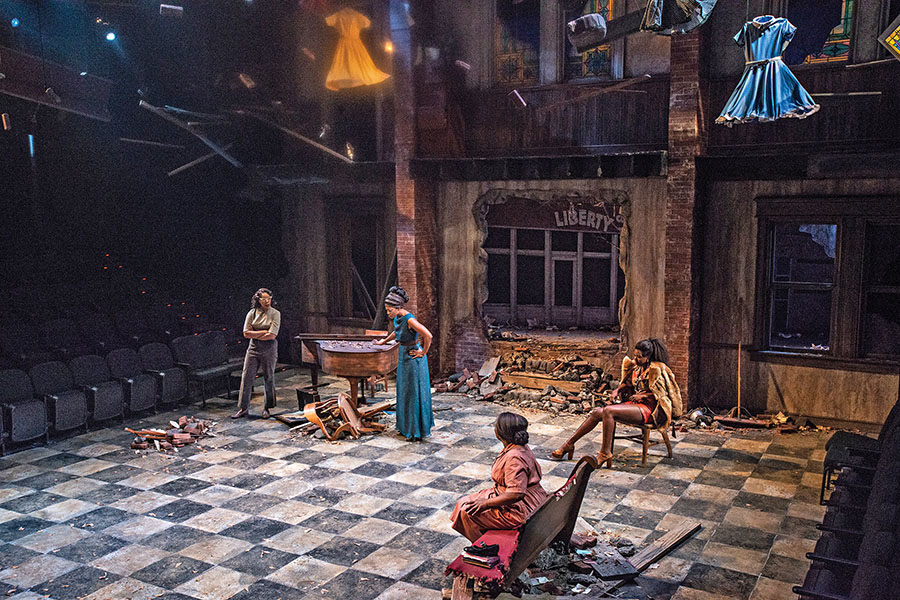
The Four Heartbeats
Christina Ham’s Nina Simone: Four Women uses the themes of its title subject’s powerful music to illustrate archetypes of Black womanhood. In January 2019, for Lydia Fort’s production at Alabama Shakespeare Festival, sound designer Sharath Patel tapped an even more elemental resource: He used biological rhythms from the show’s four performers as part of his design.
Some of these sounds included breath, blood pressure, and heartbeat. The result was a sonic landscape incorporating a variety of low-frequency sounds that gave new life to Simone’s heartfelt music.
“I tried to find natural themes and progressions to complement the songs,” Patel said. “I’m a bit of a research nut with my designs, and was with this show especially.” It’s not just cloistered research he relishes: He also loves to talk to people in the cities he visits in hopes of tracking down sounds that may be integrated into his work.
He noted the differences in Nina Simone’s music throughout her career, particularly pre- and post-Civil Rights Movement, and flagged another crucial set of differences integral to Ham’s show. “The big question was, how do we represent these four girls’ power and energy?” Patel mused. “And Lydia, the director, really fostered the relationships between the designers.”
In performance many of the sounds emerged from the set itself. “When I asked if speakers could be integrated with the set, the scenic designer [Sean Fanning] was down for that,” Patel said. “We got to collaborate more than many designers get to do.”
Indeed, Patel feels that the design team achieved symbiosis for the production, correlating its sound and light waves. “You can’t be prescriptive with sentimentality,” he said, but the design managed to create an integrated, all-encompassing feeling, with soundscapes of the four girls laughing and crying enhancing the way Reza Behjat’s lighting hit the stage through beautiful stained-glass windows.
Patel also worked closely with music director Darrian Stovall, who suggested bringing an African drum into the design. Another sound element Patel incorporated: rare recordings from Birmingham in 1963, when residents rioted in response to targeted bombings of Civil Rights leaders.
Amid the hostility of our current political climate, Patel felt that doing a show honoring Nina Simone’s music was especially important. He admitted to some discomfort about working in the South, where he said he “experienced a hate crime” in 2009. “But Alabama Shakes is a wonderfully supportive company that really changed my perspective of the South.”
Audio PlayerIn this moment from the top of Nina Simone, she is transported to the 16th Street Baptist Church where four little Black girls have just been killed. From Patel: "This soundscape included body captures of the lead actress to create a throbbing headspace, as well as full cast vocal and breath recordings to create an ominous underscore that needed to be tonal but not melodic. The sequence also included historical recordings of the actual Birmingham riots, stained glass shards poured down wooden church pews, piano string pulled like ropes, and vocal captures of young women crying." Credits: Singers and body/vocal recordings: Gabrielle Beckford, Darlene Hope, Soara-Joy Ross, Crystal Sha’nae. Vocal recording for crying: Antonisia Collins, Jalyn Crosby, Jhordyn Long, Trinity Ross. Pianist/music director: Darrian Stovall. Foley recordings and soundscape creation: Sharath Patel. Music recorded at Technical Earth Recorders in Montgomery, Ala. Recording engineers: Robert Shimp, Russell Bush, Sharath Patel.
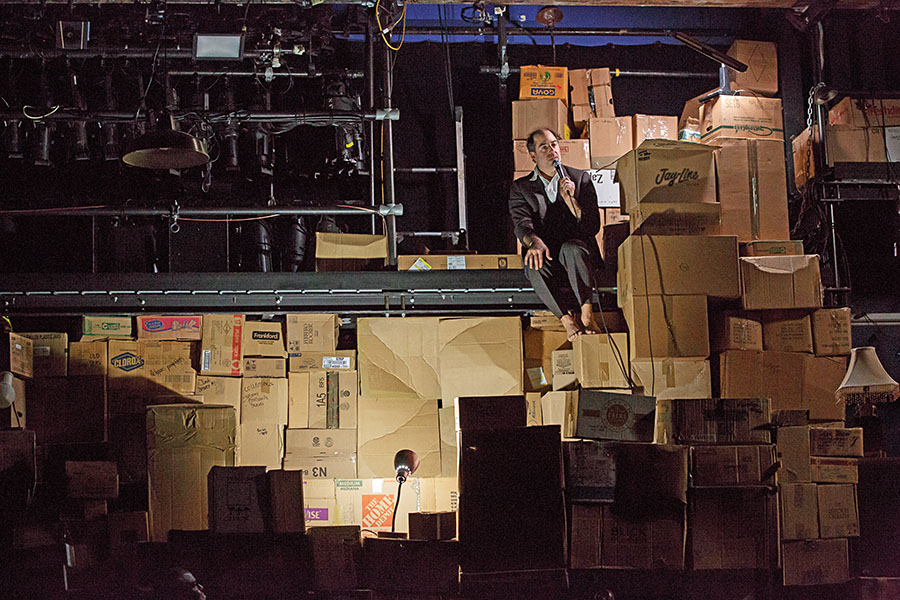
Thinking Inside the Box
In The Object Lesson at New York Theatre Workshop in 2017, audiences arrived at an overstuffed storage space to find themselves surrounded by an overwhelming amount of boxes. That claustrophobic feeling, of being surrounded by stuff, set the stage for the experiential installation that unfolded.
“The audience was not aware that the performance had begun, or that they were a part of it,” explained sound designer Nick Kourtides. “It’s anti-theatrical, really, to explore random boxes in a space. It’s disarming.”
But the relationship between people and their stuff is exactly what writer Geoff Sobelle, installation artist Steven Dufala, and director David Neumann set out to explore. The objects in the boxes were “lovingly curated” by the entire design team, Kourtides said. That these were not mere props gave the play an authentic nostalgia. They included Sobelle’s CD collection, “packed in with a working Walkman,” Kourtides noted, as well as a wacky Star Wars keepsake, a series of French lessons, and an intricate hobby train. It was a collection of “delicious experiences,” Kourtides said, and the audience experience was best when the designers were hands-off.
Eventually a show took shape in the space, with Sobelle opening a turntable and putting a record on, and assembling a living room: a chair, a gramophone, a nightstand. He extracted things from the boxes to keep the performance going, fishing around for sound elements and voice recorders. Throughout the play, he and the audience recontextualized objects from moments before. In one scene, “The Dinner Date,” Sobelle recruited a member from the audience, handing her a ringing phone. Through a P.A. system, the audience could only hear one side of the phone conversation (Sobelle’s). He invited her to a dinner date where all these extraordinary things happened: He did a tap dance on top of a cutting board, wearing ice skates, whose blades cut a series of vegetables for the dinner.
Musical interactions accompanied by a rain of packing peanuts eventually led the audience through the montage of a relationship, after which the audience member took the box of objects off the table and walked out the door. The phone rang again; Sobelle answered, and the audience heard only her side of the phone conversation through the P.A. system. Thus was the full arc of a relationship sketched, capped by a painful breakup.
Like a lot of the show, “The Dinner Date” represented full epochs in a person’s life with only a day’s worth of material. “In the end, all that is left is a pile,” Kourtides said.
The show affected him deeply, he said. “The experience transformed my thinking about what makes a theatrical object. Now, in all my work, I advocate for authenticity. If possible, the phone should always work. The light should always go on. When artists are unburdened by theatricalities, something new unlocks.”
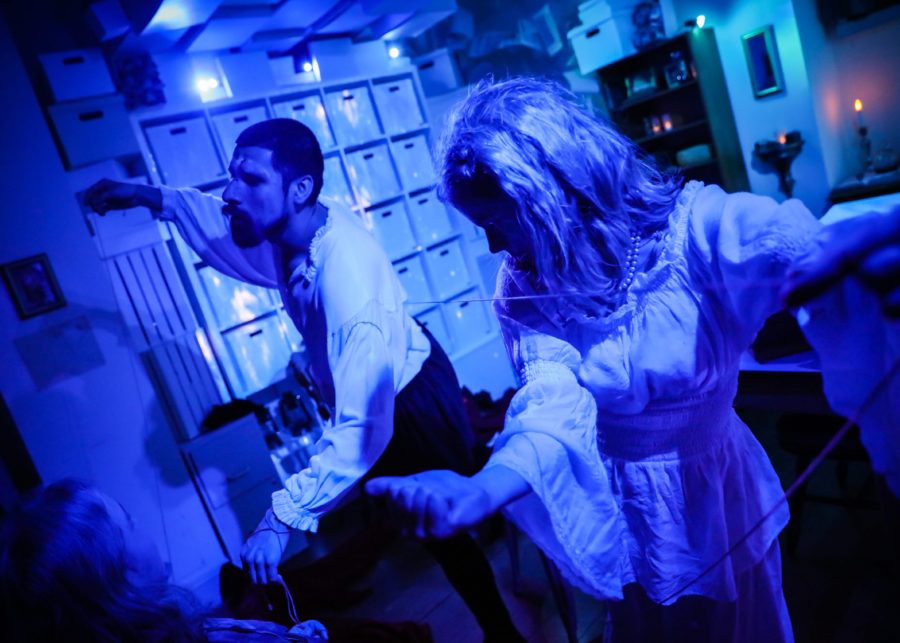
The DJ Next Door
From last September to December at the Peale Center in Baltimore, a group called Submersive Productions staged a series of immersive episodes called The Archives of the Deep Now. The series was inspired by an elusive, possibly fictional group, the Institute of Visionary History, that allegedly left behind records of a series of thought-provoking experiments in the archives of the Peale Center basement.
“We were finding all this stuff,” explained the company’s co-artistic director, Glenn Ricci. “We thought, wouldn’t it be neat if we found the records from a secret society?”
One episode, called “A Horse by the Tail in the Night,” was a durational (eight-hour) immersive piece, during which Ricci performed live, mostly improvised sound as accompaniment. The eight hours of continuous play was an Olympian feat, especially for a company that typically produces short, clear-cut shows. For most of the shows, they could simply program them into an app call QLab, and the show runner could just hit the spacebar for cues. But an eight-hour QLab session was infeasible; they needed to do the sound live.
Another reason the sound couldn’t be pre-programmed: “A lot of the script was improvised,” Ricci said, though he did “have an outline so I could see what was coming next.”
Ricci created the live soundtrack in a separate overflow room, where audience members could go to unwind while still seeing the show on a screen. Why the separate room? “The setting of the performance was very Renaissance,” Ricci said, and it would ruin the effect to have him and his equipment visible. But having him elsewhere added to the excitement. “When people got into the overflow room, it was like peeking behind a curtain,” Ricci said.
His slew of equipment included a DJ mixer, a voice microphone, Ableton Live, a washtub bass, and an early model of a Parker electric guitar. “I actually brought all this stuff I didn’t end up using,” Ricci said. “I realized I could pare it down more than I originally thought.”
The durational episode was performed just three times. “We made a point to try not to refine the design too much,” Ricci said. “A big part of the experiences is the edge we got from naturally responding to one another.”
Audiences who missed the last Deep Now installments will get another chance this summer, said Ricci. Apparently those lost archives are a gift that keeps on giving.
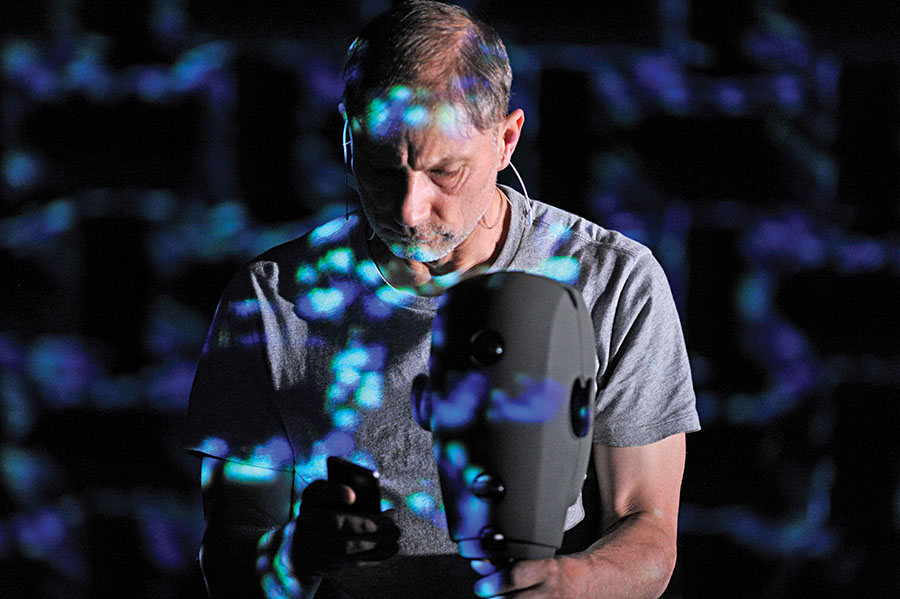
The Encounter
Petru Popescu’s book Amazon Beaming follows the true story of Loren McIntyre, a National Geographic photographer who traveled into the Amazon to take photos of the Mayoruna indigenous community—and who, when a translator contracted malaria and had to leave, learned to communicate with the Mayoruna non-verbally.
This might sound like an unlikely property for a stage adaptation, but the London-based company Complicité saw the potential, and spent years workshopping a piece inspired by the book with directors Simon McBurney and Kirsty Housley.
When building the show, McBurney, Complicité’s artistic director, accompanied sound designer Gareth Fry on a trip down the Amazon, striving to recreate Loren’s journey and have a unique interaction with the Mayorunan community.
“We wanted to get their perspective on the story and get a better sense of what it means to be in the Amazon,” Fry said. “We spent a week there, hearing stories, telling stories, recording, and getting bitten by a lot of mosquitos!”
Many of the recordings from that trip would be used in the production, in which McBurney, alone onstage, conducted what he called a “walk across your brain.” Each audience member was given their own set of headphones, resulting in a curiously intimate experience, no matter the size of the house. (The Encounter started its life at the Edinburgh International Festival in 2015 and traveled all over the world, including Broadway in 2016 and the Curran in San Francisco in 2017.)
“It allowed them to feel closer to the performer,” Fry said of the headphones. “Simon could whisper in the ear of the audience.” Apart from McBurney’s voice, the sound of the Amazon enveloped listeners so that they felt “transported away…more fully immersed in the world of the show. It let us visit the rainforest and meet the Mayoruna.”
Since, as in the original book, McIntyre didn’t share a verbal language with the indigenous folks he met, the play employed very little dialogue. “What was super important was to find a way to share Loren’s internal experience, his stream of consciousness, with the audience,” said Fry, who shared design credit with Peter Malkin.
As the show traveled to many different audiences, the play was built so that McBurney could improvise each night. “This allowed the story to develop beyond opening night,” said Fry, “to flourish rather than become staid.”
The Encounter marked Fry’s Broadway debut; his second show was the still-running blockbuster Harry Potter and the Cursed Child (he took home Tonys for both). Though the two shows could hardly be more different, Harry Potter also employs two sound operators for maximum fluidity and complexity during the show. From a rainforest to Hogwarts, theatrical sound is practical magic that hovers in the air, and the ears, for a moment, and then is gone.
Caroline Macon Fleischer is a multi-genre writer based in Chicago. She has worked with Lookingglass Theatre Company, Chicago Dramatists, Chicago Children’s Theatre, and more. She is a member of Chicago’s Poems While You Wait, and is currently pursuing a master’s in Writing and Publishing at DePaul University.

